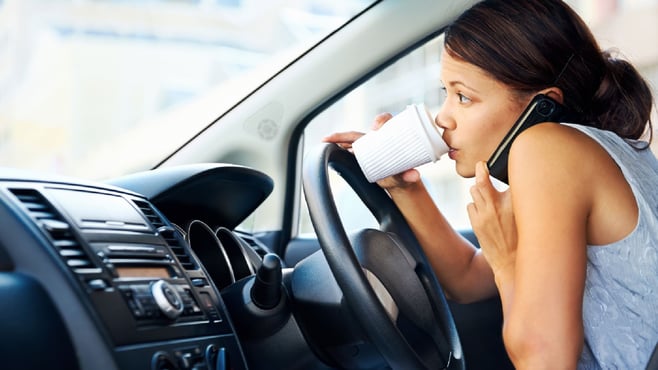Even small things can be distracting, and there are quick, easy tips we can use to avoid becoming distracted while driving. Practices such as mindfulness (though not meditation) and single tasking can assist with keeping your mind on the road while driving.

Our time, and that of our loved ones, is precious, yet it seems to fly by and sometimes we arrive home without being able to remember some aspect of our trip. If you drove home, this is related to one of the three forms of distracted driving:
- Eyes off the road (visual distraction),
- Hands off the wheel (manual distraction)
- Mind off driving (cognitive distraction)
We’re all susceptible to distraction from time to time. When this occurs while we are driving, it can delay the time it takes us to perceive and react to a safety critical event. This delay may contribute to a crash in which someone dies or is injured.
Practices such as mindfulness (though not meditation) and single tasking can assist with keeping your mind on the road while driving. These practices can also help with keeping your eyes on the road and hands on the wheel while driving.
What kinds of distractions increase the risk of being involved in a crash?
While distraction can be difficult to identify and research, evidence from a large naturalistic driving study[1] indicates some of the riskiest secondary tasks to engage in while driving include:
- Texting or dialling a mobile phone
- Reading/writing
- Reaching for an object
- Looking at objects outside the vehicle
- Browsing the internet
- Adjusting in-vehicle devices, such as the touch screen, climate control or stereo
- Eating or drinking
How does driver distraction affect driving performance?
Driving simulator and on-road studies[2] have found engagement in a secondary task while driving is associated with decreased driving performance, including:
- Increased reaction time to safety critical events
- Missed traffic signals
- Degraded lane keeping
- Poor speed control
- Unsafe gap acceptances
- Shorter or longer distances to the vehicle ahead
- Poorer visual scanning of the road environment
- Reduced awareness of the driving environment
Is it worth the risk?
You may have engaged in secondary tasks while driving without experiencing a negative consequence, but road conditions and other road users can be unpredictable. Even a small increase the time it takes a driver to become aware of and react to a safety critical event can result in road trauma. An in-depth study of crashes occurring in NSW and Victoria from 2000 to 2011 found driver distraction contributed to 16% (54/340) of injury crashes resulting in at least one hospitalisation.[3]
What can we do to avoid becoming distracted while driving?
It can be the tiniest thing that distracts you. With National Road Safety Week 16 to 23 May 2021, it is a great time to create and embed a new safety habit in your driving routine. Here are some quick tips we can use every drive to avoid becoming distracted:
- Plan your trip
- Avoid driving when tired or you’d normally be asleep
- Set yourself up before driving
- Options to not engage with your phone:
- Turn your phone off or switch it to silent and put it out of reach (such as in the boot)
- Use smartphone settings or apps to stop the phone alerting you to phone calls, texts and notifications (e.g iPhone has a setting called “Do not disturb while driving”. There are various apps Android phone users can install. These apps are activated when the phone is moving at a certain speed. The apps offer you the option to deactivate it if you are a passenger.)
- Give the phone to a passenger to manage during the trip.
- Turn off or silence text messages, notifications or alerts received on your smartwatch, or take off your smartwatch and put it out of reach
- Fasten your seatbelt and check the passengers have too
- Ensure pets are secured
- Adjust the seat, mirrors, climate control, stereo and navigation
- Find your sunglasses
- Complete personal grooming (if necessary)
- Create a calm, focused environment
- Options to not engage with your phone:
- During the drive
- Keep your eyes on the road, hands on the wheel, and mind on driving
- Scan the forward roadway for hazards
- Save the following tasks for after the trip or when you are safely parked:
- Checking or using your phone
- Consuming food or drinks
- Reaching for items
- Adjusting the stereo, navigation, and air conditioning
Ask friends, family, and passengers to support any new habits you create to reduce the likelihood of your becoming distracted while driving and help make sure you and others arrive home safely. They might be motivated to do the same!
[1] Dingus et al., 2016, US Strategic Highway Research Program 2 (SHRP2)
[2] Bayly, Young, & Regan, 2008; Horberry & Edquist, 2008; Cunningham, Regan, & Imberger, 2017; Caird et al., 2018
[3] Beanland et al., 2013, Australian In-Depth Crash Study
To learn more about how our Transport Safety team can help you, get in touch here.
